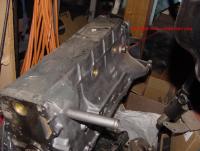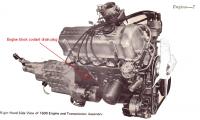Everything posted by Nissanman
-
Steering rack ends
Left hand thread to the left hand side.
-
Bushing replacement
Short answer, No!
-
rotten pillar... possible to repair?
IMO that "A" pillar is a writeoff. Best bet is to find decent donor pillar then cut and paste;)
-
Bad Voltage Regulator?
I would advise you to have the Charging System checked by a reputable Shop. It may be a simple wiring fault but they will be able to fully diagnose the problem.
-
Bad Voltage Regulator?
You have a broken Voltage Regulator. The overcharging you noticed when the bulbs blew was the first issue. Now it appears to be not permitting a charge condition at all:rolleyes: The VR is adjustable but in this day and age it is more convenient to replace it with a new part. The charge voltage should be ~13.6 - 13.8V when the engine is idling. Extreme - or + readings on the Ammeter are the indications of a fault condition.
-
Lean and injectors
I'm a bit confused, do you mean 4 of the 6 SPARKPLUGS had white electrodes? If so, that can mean a lean mixture as you say. See this chart. The only satisfactory way to check if the injectors are not working to full flow rate is to remove them and have them flow tested. I f you are going to do that you may as well replace them with the product you linked above:bulb:
-
Cold start issue
Cold environments are detrimental to batteries, if they are borderline. Cold also causes metal to contract and that also means wiring. If there is a faulty wire or connection somewhere, cold can cause that electrical function to be kaput until it expands again. But, as already mentioned, check the battery voltage prior to cranking the engine. If it is at least 12V then that is reasonable. The next port of call is the starter solenoid etc. Electrickery is really good fun, really:rolleyes:
-
Undercoating wheel wells
Good advice but could I just add this. I have done quite a bit of rust repairs, on Nissans mainly, and if there is anything that I reckon the factory does wrong is applying seam sealer BEFORE treating and priming the seams. I realise Nissan isn't the only Manufacture that does this but, it is the only one that concerns me;) The number of times that I strip a panel bare and the only visible rust is in the cracks crevices and joins, from which I have picked out the original seam sealer :stupid: So, a word of advice from my experience. Only apply seam sealer to a seam which has been de-rusted, prepared and adequately etch primed. The Stone Guard product is excellent and you can apply top coat colour to it and have the car look ex factory:cool: There is a wee bit of skill involved in applying the stuff, since it has a special applicator. However you will soon get the hang of it and depending on your desired finish, several coats can be applied.
-
2010 Skyline Nationals Show'n'Shine, Adelaide
Added some pics. to the album taken of the Track Day at Mallala Motorsport Park, north of Adelaide held 120910. Track Day starts at pic.79 http://http://nissanman.shutterfly.com/1443
-
2010 Skyline Nationals Show'n'Shine, Adelaide
Show and Shine held Saturday 110910 at Wigley Reserve Adelaide. For your viewing pleasure an Album has been created at: - http://nissanman.shutterfly.com/1443 Top day, top company, and I saw and touched GODZILLA!!
-
What are your favorite Quotes?
"I've got nothing against dying. I just don't want to be there when it happens!" Woody Allen :ermm:
-
What are your favorite Quotes?
"The people who vote, decide NOTHING! The people who COUNT the votes, decide EVERYTHING!" Joseph Stalin :rolleyes:
-
compression test results
You qualified the results by saying you did a COLD compression test:rolleyes: With that, I would not get unduly concerned about the figures, since a meaningful CT is done on a motor at normal operating temp. I'd drive it and see how it performs THEN, if you so desire, do an other CT when you get home, on a nice warm engine. As an aside, low compression in #6 can be an indicator of a corroded head or damaged head gasket. Since #6 is the lowest of the head and any sludge in the cooling system tends to attack the head and gasket at the lowest point. Same happens to #4 in the L4 series and #4 in the FJ20 and.... I'm sure you get the pattern:ermm: However a good quality coolant additive and regular use and periodical flushing of the cooling system is a good plan:bulb:
-
New Z owner problems
Well, I think you have determined most of the problems. NO sensor should be by-passed in the wiring OR read infinity. Someone has been systematically by-passing these issues by doing wiring fudges. I suggest that you replace the suspect sensors and take it from there.
-
Engine water drain plug
My apologies, I assumed the L4 and L6 drains were in the same place:ermm::ermm: Take 2: - L6 engine block coolant drain.
-
Engine water drain plug
- Blue smoke and high capicity oil pump
-
Engine water drain plug
Directly below the heater connection to the cylinder head, immediately forward of the starter motor mount. It is on the down hill side of the engine, not the intake side.
-
Wiring Problems.
My advice is you need to isolate a few things to narrow the problem down. Remove all the indicator bulbs and check their sockets for corrosion etc. Leave them out for now so you can do some testing. Remove the fuse and fit a 12V bulb temporarily across the fuse contacts. Operate the indicator mechanism. If there is still a short the bulb will glow brightly. If not, you can then replace the bulbs 1 by 1 to see if the fuse bulb shows a short. It is likely that the indicator mechanism is shorting but also make sure all the bulbs are the correct type.
-
Tie rod left hand thread lock nut
As far as the LHT locknut is concerned, I think you'll find the 510, 610 and perhaps the 810 sedans all used the same nuts as the Z:bulb: The grease reservoir can be replaced with a conventional nipple/zerk fitting.
-
Front end clunk after strut/spring R&R
You might want to verify that the gland nut in the strut tubes actually bears down tightly on the top of the strut insert and is not bottomed out on the internal thread. Unless the inserts are positively clamped, they can rock side to side and vertically as the steering/suspension moves. If the inserts are loose, adding a spacer/washer underneath them or on top for that matter, will allow the gland nut to do its' job. If you can wobble the shock shaft, the inserts are loose:rolleyes:
-
Another off the wall question
There are two, one at the front as you have found, the other is between cyl# 5 & 6 on the manifold side. All "L" series use them so Nissan Parts would probably still have them in stock.
-
SU carb engine with a L28
I had an L28 EFI engine in my '73 240Z that had the stock 240Z SUs fitted to it. They worked very well and the engine responded excellently:) I don't believe you will have to modify the carbs. at all, just make sure the fuel supply pressure is correct and use a fuel return line to avoid vapour lock in hot weather.
-
Which end goes up?
Tighter coils to the top is usual. The rears are likely to be reverseable, i.e. no difference in coil spacing.
-
Help identifying mystery holes.
The two holes by the radiator support panel are mounting holes for the front guards. There is a short vertical flange on the guard that bolts to these holes. Not sure about the other hole, it is underneath the hood hinge mechanism though:ermm:







